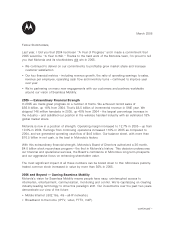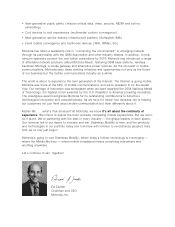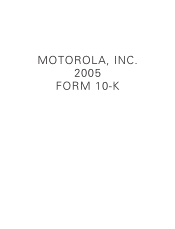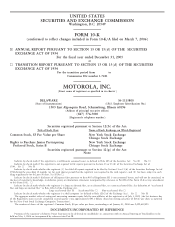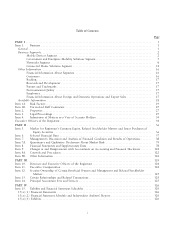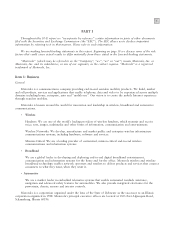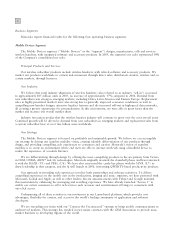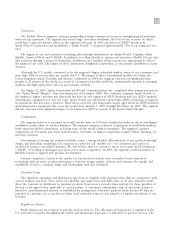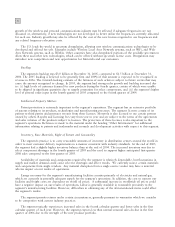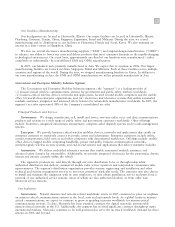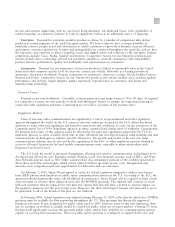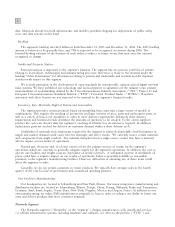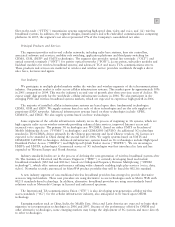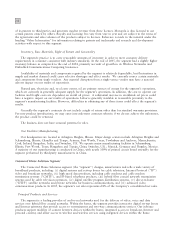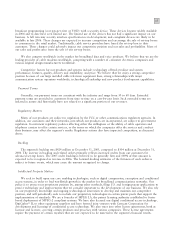Motorola 2005 Annual Report Download - page 13
Download and view the complete annual report
Please find page 13 of the 2005 Motorola annual report below. You can navigate through the pages in the report by either clicking on the pages listed below, or by using the keyword search tool below to find specific information within the annual report.
6
Enterprise: Increasingly, businesses are requiring more complex communications systems to support business-
critical communications. Motorola's heritage of providing complex, secure, mission-critical communications makes
us uniquely qualified to provide the business-critical reliability, security and connectivity that enterprise customers
demand.
Automotive: 2005 was a challenging year for automobile manufacturers and suppliers, primarily in North
America. A number of our key automotive customers lost market share in 2005, which impacted our business
results. As a leading global supplier in the automotive electronics industry, Motorola is constantly assessing ways to
enhance the strategy of its automotive electronics business.
Our Strategy
The segment is the leading provider of mission-critical systems worldwide, with more than 65 years of
experience in custom, rugged devices, public safety-grade private networks, sophisticated encryption technology,
interoperable voice and broadband data, and complex network design, optimization and implementation. We
believe that Motorola is best positioned to deliver seamless, secure and integrated point solutions across the
enterprise, vehicle and home, as well as across other wireless applications and communications systems.
Government: Key elements in our government strategy include: (i) providing integrated voice, data and
broadband over wireless systems at the local, state and national levels, (ii) benefiting from the ongoing migration
from analog to digital end-to-end radio systems, (iii) providing Project 25 and TETRA standards-based voice and
data networking systems around the world, and (iv) implementing interoperable communications and information
systems, especially related to global homeland security.
Enterprise: Key elements in our enterprise strategy include offering a comprehensive portfolio of products
and services to help businesses: (i) streamline their supply chains, (ii) improve customer service in the field, (iii)
increase data collection accuracy, and (iv) enhance worker productivity.
Automotive: Key elements in our automotive strategy include: (i) optimizing Motorola's automotive product
portfolio, (ii) investing in and protecting our core automotive business, (iii) enhancing Telematics to secure next-
generation platforms, and (iv) expanding our business in Asia, particularly in China.
Customers
The principal Government customers are public safety agencies, such as police, fire, emergency management
services and military. The principal Enterprise customers include enterprise businesses engaging in manufacturing,
transportation, utilities, courier services, field services and financial services. The principal Automotive customers are
large automobile manufacturers, primarily in North America.
Net sales to our top five customers represented approximately 20% of our total net sales. The loss of one or
more of these customers could have a material adverse effect on the segment's business. Net sales to customers in
North America represented 69% of the segment's net sales.
Competition
Government: We provide communications and information systems compliant with both existing industry
digital standards, TETRA and Project 25. We experience widespread competition from numerous competitors
ranging from some of the world's largest diversified companies to foreign, state-owned telecommunications
companies to many small, specialized firms. Many competitors have their principal manufacturing operations
located outside the U.S., which may serve to reduce their manufacturing costs and enhance their brand recognition
in their locale. Major competitors include: M/A-Com, EADS Telecommunications, Kenwood, EF Johnson and large
system integrators.
We may also act as a subcontractor to a large system integrator based on a number of competitive factors and
customer requirements. As demand for fully-integrated voice, data and broadband over wireless systems at the local,
state and national government levels continues, we may face additional competition from public
telecommunications carriers.
Competitive factors for our Government products and systems include: price; technology offered and standards
compliance; product features, performance, quality and availability; and the quality and availability of support


